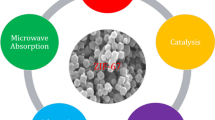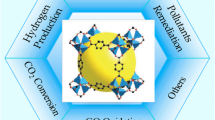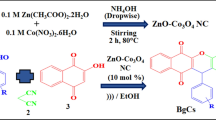Abstract
A highly efficient and straightforward one-pot three-component synthesis of functionalized 2-amino-4H-chromenes and indole-substituted 3-amino-1H-benzo[f]chromenes have been developed by 3-amino-1,2,4-triazole supported on hydroxyapatite-encapsulated-γ-Fe2O3 (γ-Fe2O3@HAp@CPTMS@AT) as the new magnetically recyclable heterogeneous basic nanocatalyst. The wide range of valuable 4H-chromene and 1H-chromene structures having different substituents were efficiently synthesized using one-pot tandem Knoevenagel cyclocondensation reaction of aromatic aldehydes, active methylene nitriles (malononitrile and 3-cyanoacetylindole) and diverse phenolic nucleophiles (resorcinol, α-naphthol and β-naphthol) in the presence of nano γ-Fe2O3@HAp@CPTMS@AT in EtOH. The structure and morphology of the synthesized nanocatalyst were characterized by using various techniques such as FT-IR, FESEM, EDS, XRD, TGA-DTA and VSM. The catalytic activity of nano γ-Fe2O3@HAp@CPTMS@AT was evaluated and the results indicated its applicability as a novel, highly efficient, green, recyclable and promising heterogeneous basic nanocatalyst for the synthesis of 4H-chromene and 1H-chromene derivatives.











Similar content being viewed by others
References
Duan H, Wang D, Li Y (2015) Green chemistry for nanoparticle synthesis. Chem Soc Rev 44(16):5778–5792
Anastas PT, Bartlett LB, Kirchhoff MM, Williamson TC (2000) The role of catalysis in the design, development, and implementation of green chemistry. Catal Today 55(1–2):11–22
Gawande MB, Branco PS, Nogueira ID, Ghumman CAA, Bundaleski N, Santos A, Teodoro OM, Luque R (2013) Catalytic applications of a versatile magnetically separable Fe–Mo (Nanocat-Fe–Mo) nanocatalyst. Green Chem 15(3):682–689
Gawande MB, Branco PS, Varma RS (2013) Nano-magnetite (Fe3O4) as a support for recyclable catalysts in the development of sustainable methodologies. Chem Soc Rev 42(8):3371–3393
Anastas PT, Kirchhoff MM, Williamson TC (2001) Catalysis as a foundational pillar of green chemistry. Appl Catal A Gen 221(1–2):3–13
Gawande MB, Bonifácio VD, Luque R, Branco PS, Varma RS (2013) Benign by design: catalyst-free in-water, on-water green chemical methodologies in organic synthesis. Chem Soc Rev 42(12):5522–5551
Gawande MB, Bonifacio VD, Luque R, Branco PS, Varma RS (2014) Solvent-free and catalysts-free chemistry: a benign pathway to sustainability. ChemSusChem 7(1):24–44
Gawande MB, Shelke SN, Zboril R, Varma RS (2014) Microwave-assisted chemistry: synthetic applications for rapid assembly of nanomaterials and organics. Acc Chem Res 47(4):1338–1348
Sheldon RA (2012) Fundamentals of green chemistry: efficiency in reaction design. Chem Soc Rev 41(4):1437–1451
Tanaka K, Kaupp G (2003) Solvent-free organic synthesis, 5. Wiley Online Library, New York
Banerjee S, Sereda G (2009) One-step, three-component synthesis of highly substituted pyridines using silica nanoparticle as reusable catalyst. Tetrahedron Lett 50(50):6959–6962
Polshettiwar V, Luque R, Fihri A, Zhu H, Bouhrara M, Basset J-M (2011) Magnetically recoverable nanocatalysts. Chem Rev 111(5):3036–3075
Mohsenimehr M, Mamaghani M, Shirini F, Sheykhan M, Moghaddam FA (2014) One-pot synthesis of novel pyrido[2,3-d]pyrimidines using HAp-encapsulated-γ-Fe2O3 supported sulfonic acid nanocatalyst under solvent-free conditions. Chin Chem Lett 25(10):1387–1391
Shylesh S, Schünemann V, Thiel WR (2010) Magnetically separable nanocatalysts: bridges between homogeneous and heterogeneous catalysis. Angew Chem Int Edit 49(20):3428–3459
Rossi LM, Costa NJ, Silva FP, Goncalves RV (2013) Magnetic nanocatalysts: supported metal nanoparticles for catalytic applications. Nanotechnol Rev 2(5):597–614
Baig RN, Varma RS (2013) Magnetically retrievable catalysts for organic synthesis. Chem Commun 49(8):752–770
Tanabe K, Misono M, Hattori H, Ono Y (1990) New solid acids and bases: their catalytic properties, 51. Elsevier, Amsterdam
Itoh H, Utamapanya S, Stark JV, Klabunde KJ, Schlup JR (1993) Nanoscale metal oxide particles as chemical reagents. Intrinsic effects of particle size on hydroxyl content and on reactivity and acid/base properties of ultrafine magnesium oxide. Chem Mater 5(1):71–77
Melero JA, van Grieken R, Morales G (2006) Advances in the synthesis and catalytic applications of organosulfonic-functionalized mesostructured materials. Chem Rev 106(9):3790–3812
Astruc D, Lu F, Aranzaes JR (2005) Nanoparticles as recyclable catalysts: the frontier between homogeneous and heterogeneous catalysis. Angew Chem Int Edit 44(48):7852–7872
Mornet S, Vasseur S, Grasset F, Duguet E (2004) Magnetic nanoparticle design for medical diagnosis and therapy. J Mater Chem 14(14):2161–2175
Yoon H, Ko S, Jang J (2007) Nitrogen-doped magnetic carbon nanoparticles as catalyst supports for efficient recovery and recycling. Chem Commun 14:1468–1470
Ye E, Liu B, Fan WY (2007) Preparation of graphite-coated iron nanoparticles using pulsed laser decomposition of Fe3(CO)12 and PPh3 in hexane. Chem Mater 19(15):3845–3849
Elliott JC (2013) Structure and chemistry of the apatites and other calcium orthophosphates, 18. Elsevier, Amsterdam
Julián-López B, Boissière C, Chanéac C, Grosso D, Vasseur S, Miraux S, Duguet E, Sanchez C (2007) Mesoporous maghemite–organosilica microspheres: a promising route towards multifunctional platforms for smart diagnosis and therapy. J Mater Chem 17(16):1563–1569
Mori K, Kanai S, Hara T, Mizugaki T, Ebitani K, Jitsukawa K, Kaneda K (2007) Development of ruthenium–hydroxyapatite-encapsulated superparamagnetic γ-Fe2O3 nanocrystallites as an efficient oxidation catalyst by molecular oxygen. Chem mater 19(6):1249–1256
Hara T, Kaneta T, Mori K, Mitsudome T, Mizugaki T, Ebitani K, Kaneda K (2007) Magnetically recoverable heterogeneous catalyst: palladium nanocluster supported on hydroxyapatite-encapsulated γ-Fe2O3 nanocrystallites for highly efficient dehalogenation with molecular hydrogen. Green Chem 9(11):1246–1251
Brahmachari G, Banerjee B (2013) Facile and one-pot access to diverse and densely functionalized 2-amino-3-cyano-4H-pyrans and pyran-annulated heterocyclic scaffolds via an eco-friendly multicomponent reaction at room temperature using urea as a novel organo-catalyst. ACS Sustain Chem Eng 2(3):411–422
Geen GR, Evans JM, Vong AK (1995) Pyrans and their benzo derivatives: applications. Compr Heterocycl Chem II 5:469–500
Khafagy MM, El-Wahab AHA, Eid FA, El-Agrody AM (2002) Synthesis of halogen derivatives of benzo[h]chromene and benzo[a]anthracene with promising antimicrobial activities. Il Farmaco 57(9):715–722
Martínez-Grau A, Marco J (1997) Friedländer reaction on 2-amino-3-cyano-4H-pyrans: synthesis of derivatives of 4H-pyran[2,3-b]quinoline, new tacrine analogues. Bioorg Med Chem Lett 7(24):3165–3170
Mohr SJ, Chirigos MA, Fuhrman FS, Pryor JW (1975) Pyran copolymer as an effective adjuvant to chemotherapy against a murine leukemia and solid tumor. Cancer Res 35(12):3750–3754
Bianchi G, Tava A (1987) Synthesis of (2R)-(+)-2,3-dihydro-2,6-dimethyl-4H-pyran-4-one, a homologue of pheromones of a species in the hepialidae family. Agric Biol Chem 51(7):2001–2002
Rueping M, Sugiono E, Merino E (2008) Asymmetric organocatalysis: an efficient enantioselective access to benzopyranes and chromenes. Chem A Eur J 14(21):6329–6332
Xu Z-Q, Hollingshead MG, Borgel S, Elder C, Khilevich A, Flavin MT (1999) In vivo anti-HIV activity of (+)-calanolide A in the hollow fiber mouse model. Bioorg Med Chem Lett 9(2):133–138
Kemnitzer W, Drewe J, Jiang S, Zhang H, Zhao J, Crogan-Grundy C, Xu L, Lamothe S, Gourdeau H, Denis R (2007) Discovery of 4-aryl-4H-chromenes as a new series of apoptosis inducers using a cell-and caspase-based high-throughput screening assay. 3. Structure–activity relationships of fused rings at the 7,8-positions. J Med Chem 50(12):2858–2864
Raj T, Bhatia RK, Sharma M, Saxena A, Ishar M (2010) Cytotoxic activity of 3-(5-phenyl-3H-[1,2,4]dithiazol-3-yl)chromen-4-ones and 4-oxo-4H-chromene-3-carbothioic acid N-phenylamides. Eur J Med Chem 45(2):790–794
Eiden F, Denk F (1991) Synthesis of CNS-activity of pyran derivatives: 6,8-dioxabicyclo (3,2,1) octane. Arch Pharm 324(6):353–354
Minaev BF, Valiev RR, Nikonova EN, Gadirov RM, Solodova TA, Kopylova TN, Tel’minov EN (2015) Computational and experimental investigation of the optical properties of the chromene dyes. J Phys Chem A 119(10):1948–1956
Jiang H, Ferrara G, Zhang X, Oniwa K, Islam A, Han L, Sun YJ, Bao M, Asao N, Yamamoto Y (2015) Triflic acid mediated cascade cyclization of aryldiynes for the synthesis of indeno[1,2-c]chromenes: application to dye-sensitized solar cells. Chem A Eur J 21(10):4065–4070
Wolfrom ML, Koos E, Bhat HB (1967) Osage orange pigments. XVIII. Synthesis of osajaxanthone. J Org Chem 32(4):1058–1060
Ellis GP (2009) Chromenes, chromanones, and chromones, 100. Wiley, New York
Moorthy JN, Venkatakrishnan P, Sengupta S, Baidya M (2006) Facile synthesis, fluorescence, and photochromism of novel helical pyrones and chromenes. Org Lett 8(21):4891–4894
Zhang AQ, Zhang M, Chen HH, Chen J, Chen HY (2007) Convenient method for synthesis of substituted 2-amino-2-chromenes. Synth Commun 37(2):231–235
Zhou D, Ren Z, Chen J, Cao W, Deng H (2008) Solvent-free one-pot approach for synthesis of substituted 2-aminochromenes. J Heterocycl Chem 45(6):1865–1867
Mobinikhaledi A, Moghanian H, Sasani F (2011) Microwave-assisted one-pot synthesis of 2-amino-2-chromenes using piperazine as a catalyst under solvent-free conditions. Synth React Inorg Met Org Nano Metal Chem 41(3):262–265
Raghuvanshi DS, Singh KN (2010) An expeditious synthesis of novel pyranopyridine derivatives involving chromenes under controlled microwave irradiation. Arkivoc 10:305–317
Mamaghani M, Tabatabaeian K, Shirini F, Rassa M (2012) An expeditious regioselective synthesis of novel bioactive indole-substituted chromene derivatives via one-pot three-component reaction. Bioorg Med Chem Lett 22(18):5956–5960
Kumar BS, Srinivasulu N, Udupi R, Rajitha B, Reddy YT, Reddy PN, Kumar P (2006) Efficient synthesis of benzo[g]- and benzo[h]chromene derivatives by one-pot three-component condensation of aromatic aldehydes with active methylene compounds and naphthols. Russ J Org Chem 42(12):1813–1815
Eshghi H, Damavandi S, Zohuri G (2011) Efficient one-pot synthesis of 2-amino-4H-chromenes catalyzed by ferric hydrogen sulfate and Zr-based catalysts of FI. Synth React Inorg Met Org Nano Metal Chem 41(9):1067–1073
Kumar A, Sharma S, Maurya RA, Sarkar J (2009) Diversity oriented synthesis of benzoxanthene and benzochromene libraries via one-pot, three-component reactions and their anti-proliferative activity. J Comb Chem 12(1):20–24
Makarem S, Mohammadi A, Fakhari A (2008) A multi-component electro-organic synthesis of 2-amino-4H-chromenes. Tetrahedron Lett 49(50):7194–7196
Datta B, Pasha M (2012) Glycine catalyzed convenient synthesis of 2-amino-4H-chromenes in aqueous medium under sonic condition. Ultrason Sonochem 19(4):725–728
Jin T-S, Xiao J-C, Wang S-J, Li T-S (2004) Ultrasound-assisted synthesis of 2-amino-2-chromenes with cetyltrimethylammonium bromide in aqueous media. Ultrason Sonochem 11(6):393–397
Moosavi-Zare AR, Zolfigol MA, Khaledian O, Khakyzadeh V, Beyzavi MH, Kruger HG (2014) Tandem Knoevenagel–Michael-cyclocondensation reaction of malononitrile, various aldehydes and 2-naphthol over acetic acid functionalized ionic liquid. Chem Eng J 248:122–127
Kale SR, Kahandal SS, Burange AS, Gawande MB, Jayaram RV (2013) A benign synthesis of 2-amino-4H-chromene in aqueous medium using hydrotalcite (HT) as a heterogeneous base catalyst. Catal Sci Technol 3(8):2050–2056
Dekamin MG, Eslami M (2014) Highly efficient organocatalytic synthesis of diverse and densely functionalized 2-amino-3-cyano-4H-pyrans under mechanochemical ball milling. Green Chem 16(12):4914–4921
Mondal J, Modak A, Nandi M, Uyama H, Bhaumik A (2012) Triazine functionalized ordered mesoporous organosilica as a novel organocatalyst for the facile one-pot synthesis of 2-amino-4H-chromenes under solvent-free conditions. RSC Adv 2(30):11306–11317
Albadi J, Razeghi A, Mansournezhad A, Azarian Z (2013) CuO–CeO2 nanocomposite catalyzed efficient synthesis of aminochromenes. J Nanostruct Chem 3(1):85
Wang Y, Luo J, Xing T, Liu Z (2013) Synthesis of a novel piperidine-functionalized poly (ethylene glycol) bridged dicationic ionic liquid and its application in one-pot synthesis of substituted 2-amino-2-chromenes and 3,4-dihydropyrano[3,2-c]chromenes in aqueous media. Monatsh Chem 144(12):1871–1876
Kundu SK, Bhaumik A (2015) A triazine-based porous organic polymer: a novel heterogeneous basic organocatalyst for facile one-pot synthesis of 2-amino-4H-chromenes. RSC Adv 5(41):32730–32739
Zhang Y, Zhao Y, Xia C (2009) Basic ionic liquids supported on hydroxyapatite-encapsulated γ-Fe2O3 nanocrystallites: an efficient magnetic and recyclable heterogeneous catalyst for aqueous Knoevenagel condensation. J Mol Catal A Chem 306(1–2):107–112
Zhang Y, Xia C (2009) Magnetic hydroxyapatite-encapsulated γ-Fe2O3 nanoparticles functionalized with basic ionic liquids for aqueous Knoevenagel condensation. Appl Catal A 366(1):141–147
Sheykhan M, Ma’mani L, Ebrahimi A, Heydari A (2011) Sulfamic acid heterogenized on hydroxyapatite-encapsulated γ-Fe2O3 nanoparticles as a magnetic green interphase catalyst. J Mol Catal A Chem 335(1–2):253–261
Xie W, Han Y, Tai S (2017) Biodiesel production using biguanide-functionalized hydroxyapatite-encapsulated-γ-Fe2O3 nanoparticles. Fuel 210:83–90
Mamaghani M, Shirini F, Sheykhan M, Mohsenimehr M (2015) Synthesis of a copper (II) complex covalently anchoring a (2-iminomethyl) phenol moiety supported on HAp-encapsulated-α-Fe2O3 as an inorganic–organic hybrid magnetic nanocatalyst for the synthesis of primary and secondary amides. RSC Adv 5(55):44524–44529
Ahmadiazar M, Mamaghani M (2018) Synthesis of (2-iminomethyl)pyridine moiety supported on hydroxyapatite-encapsulated-γ-Fe2O3 as an inorganic-organic hybrid magnetic nanocatalyst for the synthesis of thiazole derivatives under ultrasonic irradiation. Curr Org Chem 22(13):1326–1334
Kheirkhah L, Mamaghani M, Yahyazadeh A, Mahmoodi NO (2018) HAp-encapsulated γ-Fe2O3-supported dual acidic heterogeneous catalyst for highly efficient one-pot synthesis of benzoxanthenones and 3-pyranylindoles. Appl Organomet Chem 32(2):e4072
Jahanshahi P, Mamaghani M, Haghbin F, Nia RH, Rassa M (2018) One-pot chemoselective synthesis of novel pyrrole-substituted pyrido[2,3-d]pyrimidines using [γ-Fe2O3@HAp-SO3H] as an efficient nanocatalyst. J Mol Struct 1155:520–529
Jahanshahi P, Mamaghani M (2019) Chemodivergent, multicomponent-tandem facile synthesis of novel 1H-pyrazolo[1,2-b]phthalazine-5,10-dione using acetic acid functionalized imidazolium salt {[cmdmim]I} as a recyclable catalyst. New J Chem 43(21):8266–8278
Bahareh B, Mamaghani M, Mokhtary M (2019) Sustainable approach to the synthesis of 1,4-disubstitued triazoles using reusable Cu(II) complex supported on hydroxyapatite-encapsulated α-Fe2O3 as organic–inorganic hybrid nanocatalyst. Reac Kinet Mech Cat 128(1):379–394
Barazandehdoust M, Mamaghani M, Kefayati H (2020) A novel phosphine-free and recyclable palladium organic–inorganic hybrid magnetic nanocatalyst for Heck cross-coupling reactions. Reac Kinet Mech Cat 129(2):1007–1026
Zolfigol MA, Yarie M, Baghery S (2016) Application of {[4,4′-BPyH][C(CN)3]2} as a bifunctional nanostructured molten salt catalyst for the preparation of 2-amino-4H-chromene derivatives under solvent-free and benign conditions. Synlett 27(09):1418–1422
Balalaie S, Ramezanpour S, Bararjanian M, Gross JH (2008) DABCO-catalyzed efficient synthesis of naphthopyran derivatives via one-pot three-component condensation reaction at room temperature. Synth Commun 38(7):1078–1089
Zhen Y, Lin H, Wang S, Tao M (2014) A water–ethanol on–off fiber catalyst for the synthesis of substituted 2-amino-2-chromenes. RSC Adv 4(50):26122–26128
Wang X-S, Yang G-S, Zhao G (2008) Enantioselective synthesis of naphthopyran derivatives catalyzed by bifunctional thiourea-tertiary amines. Tetrahedron Asymmetry 19(6):709–714
Kundu SK, Mondal J, Bhaumik A (2013) Tungstic acid functionalized mesoporous SBA-15: a novel heterogeneous catalyst for facile one-pot synthesis of 2-amino-4H-chromenes in aqueous medium. Dalton Trans 42(29):10515–10524
Baghbanian SM, Rezaei N, Tashakkorian H (2013) Nanozeolite clinoptilolite as a highly efficient heterogeneous catalyst for the synthesis of various 2-amino-4H-chromene derivatives in aqueous media. Green Chem 15(12):3446–3458
Acknowledgements
Authors are grateful to the Research Council of University of Guilan for the partial financial support of this work.
Author information
Authors and Affiliations
Corresponding author
Additional information
Publisher's Note
Springer Nature remains neutral with regard to jurisdictional claims in published maps and institutional affiliations.
Electronic supplementary material
Below is the link to the electronic supplementary material.
Rights and permissions
About this article
Cite this article
Jahanshahi, P., Mamaghani, M. Efficient and straightforward access to diverse and densely functionalized chromenes by 3-amino-1,2,4-triazole supported on hydroxyapatite-encapsulated- γ-Fe2O3 (γ-Fe2O3@HAp@CPTMS@AT) as a new magnetic basic nanocatalyst. Reac Kinet Mech Cat 130, 955–977 (2020). https://doi.org/10.1007/s11144-020-01825-5
Received:
Accepted:
Published:
Issue Date:
DOI: https://doi.org/10.1007/s11144-020-01825-5




